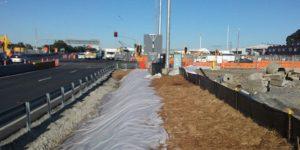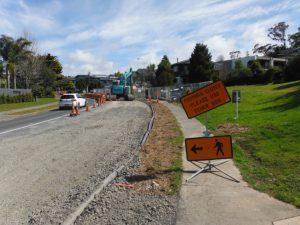Specific Tasks
Roads
Issues to look out for
Large roading projects or roads constructed at the time of a new subdivision development are not generally space constrained, so the standard tools across this toolbox apply. However, roading upgrades, repairs or realignments in an existing urban environment have unique challenges in erosion and sediment control. This is because:
- They are linear projects that may cross a number of catchments
- Roading networks can be over flow paths and the works may alter existing drainage patterns
- Works within stormwater flow paths are immediately above, in and around stormwater inlets
- The works are constrained in the amount of space that they occupy
- The works are often undertaken within a ‘live’ traffic environment
- There may be numerous adjacent properties or land use activities
- The earthwork areas and volumes are often not large in any one area, but the long and linear nature of the project has a cumulative effect
- Dust discharges from the construction area as traffic passes through can have a significant effect on local air quality.
Design essentials
In existing urban environments there is often limited space for the construction of conventional sediment control devices. Use a ‘cut and cover’ methodology, and stabilise exposed areas at the end of the each day. Depending on the extent and nature of the works, they can often be limited to works within the subgrade or widening operations that allow for a cut to waste and replace with a stabilised product (aggregate).
When planning and designing for roading activities:
- Plan the works to minimise both the extent and duration of site disturbance, especially in high-risk areas such as near watercourses and on slopes steeper than 18%
- Pumping groundwater and rainwater out of trenches or excavations generates sediment-laden water that can be difficult to treat in the roadway or limited berm areas. Use sediment control techniques in the dewatering section
- Consider the limitations of space as a result of site-specific issues including traffic management, pedestrian access, and access to commercial and residential properties
- In the urban environment, the location of buried services and the proximity of trees can also affect which ESC tools you choose
- Plan your work to avoid extended periods of exposed unsealed surfaces which will contribute fine dust to air pollution
- Plan to sweep kerbs, channels, protect and clean sumps, and sweep areas where traffic tracks sediment onto sealed surfaces, regularly.
Construction and operation
- Focus on erosion control and stabilise areas as soon as possible. Consider material selection for filling operations (ie use of hardfill).
- Stockpile topsoil and spoil separately.
- Don’t put stockpiles of topsoil, spoil or bedding material in overland flow paths or within 1 m of a hazard area such as kerb and channels, stormwater inlets, paved footpaths or driveways.
- Cover any stockpiles with geotextile fabric at the end of each day or when rain is forecast during the day.
- Remove excess spoil and/or undercut material from the site as soon as possible, or immediately incorporate it into other works on site. If possible, load all excavated material that you’re not using for backfill directly onto a truck and get it off-site.
- Stabilise exposed areas as soon as possible (use aggregate for carriageway and footpath areas and topsoil, seed and mulch/geotextile for landscaping and berm areas).
- Backfill and compact trenches or excavations as soon as possible (Note: Open trenches in an existing urban environment can also be a health and safety issue).
- Dewatering of trenches or excavations must not pollute any stormwater system or downstream watercourse. Pump sediment-laden water to a retention device for treatment and/or removal, or direct it to a tanker for appropriate off-site disposal (see the Dewatering section on our website for more information).
- Take care with all use of lime and cement to avoid discharges into stormwater or waterbodies.
- Protect waterways and stormwater networks from the residue of concrete and asphalt cutting. Block off sumps and vacuum up all residual waste so that the kerb, channel and sumps are clean.
- Regularly clean sediment from kerbs and channels, sumps, and sweep areas where vehicles track sediment from unstabilised areas onto sealed surfaces.

